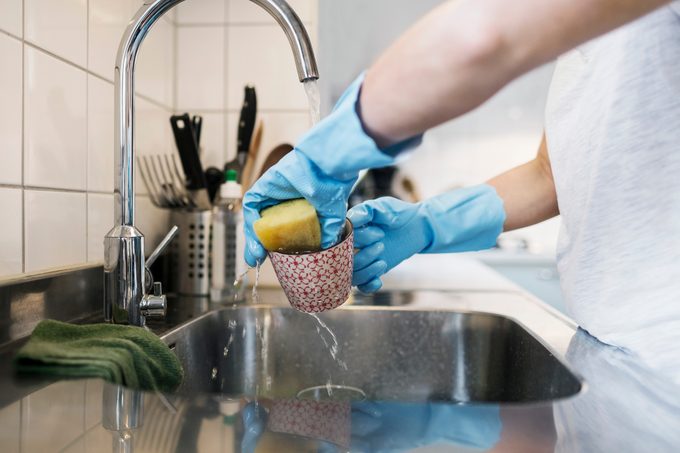How Often Should You Change Your Sponge
Every editorial product is independently selected, though we may be compensated or receive an affiliate commission if you buy something through our links. Ratings and prices are accurate and items are in stock as of time of publication.
Replacing your kitchen sponge every week or two is the best fashion to foreclose the spread of infection-causing bacteria and viruses.
When it comes to washing your dishes (sans dishwasher), you e'er brand sure to have your two essentials: Dish lather and a kitchen sponge. While it'southward of import to make clean your dishes, cutlery, kitchen gadgets, and cooking tools, it's easy to overlook the grease and grime on that sponge. Recall about it, when was the final time you replaced this tool? Last week? 3 months ago?
Chances are you probably don't replace your kitchen sponge as often as you lot should. And, as a result, it virtually likely contains bacteria, and you lot could be spreading illness-causing germs including E. coli, Salmonella, and perhaps even SARS-CoV-two, the virus that causes Covid-19. (If you want to rid your firm of the virus, here are nine EPA-registered coronavirus cleaning products to try.)
The dirty truth is that sponges are nigh as germy equally it tin get. In fact, a study in the July 2017 upshot of Sc ientific Reports suggests that kitchen sponges are germier than toilets. The researchers, including study author Markus Egert, PhD, professor for microbiology and hygiene at Furtwangen University in Schwenningen, Frg, noted there were 362 unlike kinds of leaner plant lurking in the crevices of sponges from homes. Approximately, 5.5 trillion microscopic bugs per kitchen sponge were constitute.
All sorts of creepy, crawly germs lurk in the crevices of kitchen sponges, explains Egert. Nosotros're talking bacteria, archaea, fungi, protozoa, algae, and viruses. "But, bacteria are the most abundant," he says.

A repository for germs
Sponges are the perfect repository for germs. "They are usually wet, stored in a warm place, have a huge surface, and contain many nutrients for microbes such as food residuum and even dishwashing detergent," he explains.
Bacteria don't just survive; they also thrive in this environment and can spread to your countertop and dishes you call back you're cleaning, says Phillip Delekta, PhD, instructor in microbiology at Michigan State University in E Lansing. "Viruses like [SARS-CoV-2] wouldn't multiply or stay in that location indefinitely, simply they could survive and exist spread during cleaning." Here are ten other things in your house that could be making you sick.
So, now that you know that your sponge volition scoop up all sorts of bacteria, how ofttimes should you be replacing it?
When to supercede your kitchen sponge
Replace your kitchen sponge every one to 2 weeks, Egert suggests. "In view of the trillions of germs inside a sponge, probably no domestic method volition eradicate all of them, and subsequently a few days or maybe even hours, the sponge is recolonized again." Information technology'south also fourth dimension to trash your sponge if it starts to give off a sour, mildewy stench, adds Delekta. "If yous accept a sponge that gives off an smell and has visible growth and is clearly oiled—get rid of it," he says. (Here are 15 other things you should supervene upon more often.)
How to finer clean information technology
If you want to make clean your sponge, putting it into the washing machine at 60° C (140° F), and using a bleach-containing, heavy-duty detergent is probably the all-time method, Egert suggests. He points out that this combines loftier temperature, strong chemistry, mechanics, and a sufficient corporeality of fourth dimension.
Meanwhile, Delekta suggests this method: "Lather information technology up with dish soap and rinse it with running water to affluent the bacteria and viruses of the surface of the sponge, then put it in the microwave on high for 2 minutes to impale any bacteria."
The wet office is key because placing a dry sponge in the microwave could crusade a fire, he warns.

Where and how to properly store it
Where and how you shop your sponge in between cleanings as well matters. "Keep it in a holster away from the faucet or drain to let it dry out out," Delekta adds. "The more information technology dries out the less likely it is to harbor bacteria and other germs."
It'due south too smart to utilize carve up sponges for separate areas or items. "The sponge that you lot utilise to make clean your dishes shouldn't exist the same one you use to make clean the bathroom," he says.
Also, don't use your kitchen sponge to soak up blood from meat or poultry on the countertop–as this is an excellent way to encourage bacterial growth. Clean those areas with paper towels and disinfectant sprays, Delekta suggests.
Safer alternatives
There are alternatives to sponges that are less likely to provide a safe house for bacteria and viruses and volition stand the test of time, says Jennifer J. Stagg, ND, naturopathic physician and medical director of Whole Wellness Health Center in Avon, Connecticut and author of The Bitter Prescription. "Silicone sponges and scrubbing brushes are less porous and the fabric doesn't support a moist enough surroundings for bacterial growth," she says. Dr. Stagg recommends the Kuhn Rikon brushes and scrubbers. "Some other options are microfiber dishcloths that should exist done in a washing auto on loftier heat afterward each use," she says.
Next, read about the everyday items that are dirtier than a toilet seat.
Source: https://www.thehealthy.com/home/replace-clean-kitchen-sponge/
Posted by: wynngrecond.blogspot.com


0 Response to "How Often Should You Change Your Sponge"
Post a Comment